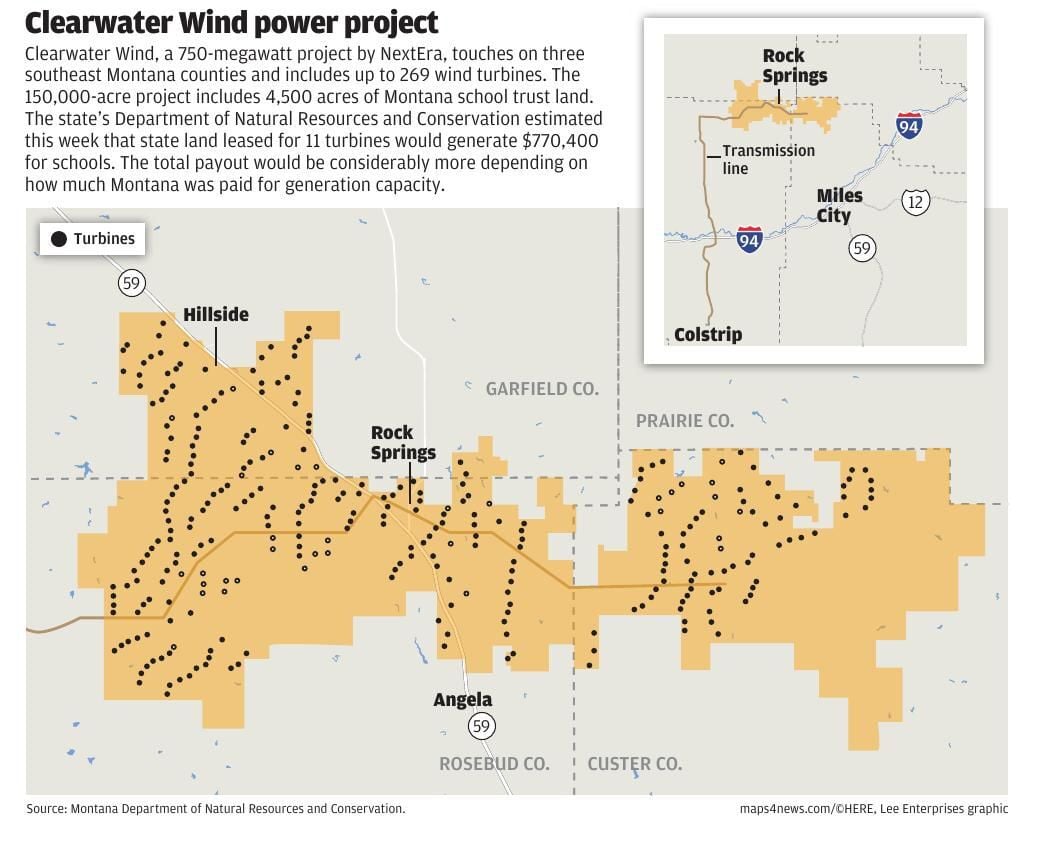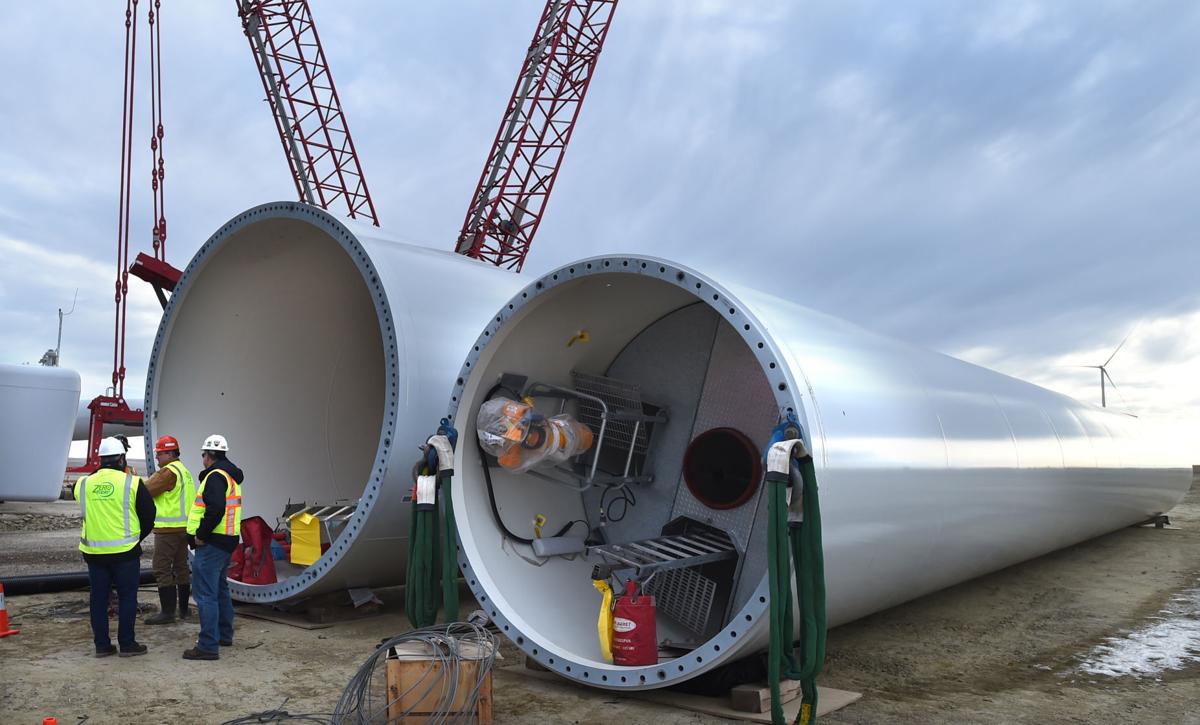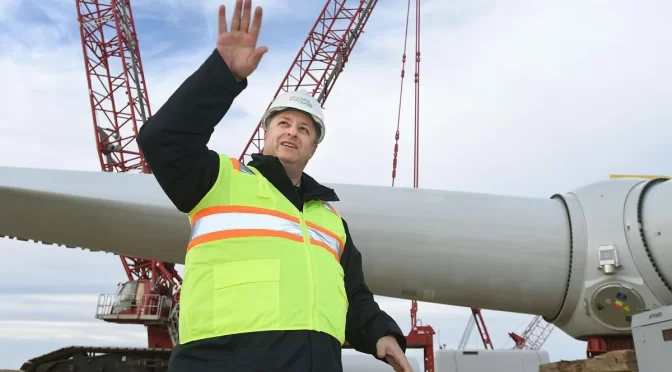On a recent winter afternoon the wind on this Eastern Montana plain was rising slowly like a tide, the cool dense air rolling in to replace what’s been warmed by daylight.
At first, the change is barely noticeable, but then the 210-foot blades of the Clearwater Wind Project start to turn. Though the blades have been feathered to catch none of what this chilly air has to offer, they turn nonetheless.
The setting is perfect for what will be Montana’s largest windfarm, said Jess Melin. A Livingston guy, Melin is executive director of renewable development for NextEra Energy Resources.
The company brands itself as the world’s largest generator of renewable energy from wind and solar. This 750-megawatt giant is NextEra’s first Montana project. Milan seems to preface all his observations about Eastern Montana with “I’m a little biased.”

“You got to have a place to put a machine, you have to have willing landowners. Very gracious landowners who have been great to work with in Eastern Montana. I’m a little biased, but I’ve always thought Eastern Montana has the best people on Earth and we found great landowners,” Milan said. “You need transmission, need a way to get your product to market. We have to build that transmission down to the Colstrip substation because this is where the fuel is. But we’re delivering this to Colstrip. One of the gems of Eastern Montana is the Colstrip transmission system.”
There’s money in the quarter-acre wind turbine leases for Montana landowners. In Clearwater’s case, the payouts over the next 30 years are expected to be $226 million. Each turbine, however, takes up about 50 square feet. The land around the turbines is available for grazing and crops.
Property taxes paid to Custer, Garfield and Rosebud counties, where Clearwater is located are $217 million over the same period.
At this site, the net capacity factor is about 40%, meaning that during the year the turbines are at maximum capacity about 40% of the time.
“There’s a definite cycle to it, but at about 40% of the year, they’re at max capacity, which means they’re going to be turning probably 80% of the year at some rotational experience,” Milan said.

Half of the project is scheduled to come online in late 2022. Colstrip stakeholder Puget Sound Energy has contracted for the first 350 megawatts of Clearwater’s capacity. Puget agreeing to purchase 350 megawatts of Clearwater capacity was crucial for launching the project. It assured that nearly half of the wind farm’s power would have a customer for the next 20 years.
The wind turbines being erected now are for Puget. The remaining 400 megawatts will be built when there’s another customer.
Favorable weather conditions have allowed the project to build out months ahead of schedule. Construction Manager Damon Steelman said the first phase of construction could finish in the spring, though conditions would have to remain favorable. With the hardest months of the Montana winter still ahead, an early finish isn’t guaranteed.
The initial flourish of 350 workers on site, pouring concrete, burying power lines, building 134 miles of new access roads and upgrading another 94 miles, has subsided. There are now 200 workers at Clearwater. There’s no man camp. Everybody drives in from the outlying area.
Clearwater’s list of potential customers is only four utilities long. Collectively representing 70% of the ownership in the nearby coal-burning Colstrip Power Plant, each owner faces a state deadline to phase out coal from its portfolio, with the first requirement coming at the end of 2025 in Washington, which is by far the largest consumer of Colstrip power.
But it’s a less often discussed detail of Washington’s climate law that benefits Clearwater, or any Montana renewable project trying to sell into the Pacific Northwest. The provision concerns the Colstrip transmission line.

When Washington legislators passed the Clean Energy Transformation Act in 2019, they didn’t just put an expiration date on coal power. Lawmakers also required that the transmission lines connected to retiring coal power plants start moving energy from another source or be removed from customer bills as early as January 2026. The requirement is based on the concept that utility customers can’t be asked to pay for assets that aren’t used and useful for service.
“The adjusted depreciation schedule must require such a qualified transmission line to be fully depreciated on or before Dec. 31, 2025,” reads the law which instructs Washington utility regulators to make the determination.

NextEra’s agreement with Puget Sound Energy requires the power to be delivered to Puget at the Colstrip substation. The freight from there is the utility’s responsibility. That arrangement, being able to deliver the power after a relatively short distance, works in favor of the project.
From the wind farm, there’s a path of steel transmission towers laid in a line that points directly to Colstrip and disappears in the rolling hills. The line will service Clearwater, located roughly 33 miles northwest of Miles City and nothing else.
Asked about the 750-megawatt scale of the wind farm, Melin said that’s the size necessary to justify the expense of the 83-mile transmission line from Clearwater to Colstrip. A smaller facility wouldn’t pencil out. The scale also matches what was available for transmission capacity at Colstrip.
Clearwater also takes up the Colstrip line transmission capacity that came available when Colstrip Units 1 and 2 retired in January 2020, after 45 years of operation. These generators were the oldest of the power plant’s 4 units, but were no longer profitable, according to Talen Energy and Puget, which split ownership in the two 307-megawatt units equally.
In June, Puget’s Andrew Padula told Lee Montana Newspapers that Clearwater’s electricity output was expected to peak at times of the year when wind farms in the Pacific Northwest were less active.
“Montana wind provides a geographical diversity relative to PSE’s wind resources in Washington, along with a winter generation profile that fits well with PSE’s peak load need,” Padula said.
Montana renewables
The other Colstrip owners facing Washington’s coal phase out, have also identified Montana wind power as a cost-effective renewable source. The projects they develop or contract with will keep Montana in the energy export business. As 364 megawatts of coal-fired generation retired in Montana over the past two years, development of wind energy for export grew by 990 megawatts, specifically because Colstrip Power Plant owners Puget Sound Energy and PacifiCorp invested in Montana renewables.

PacifiCorp became the first Colstrip owner to build a Montana wind farm in 2020 when it constructed the 240-megawatt Pryor Mountain Wind Farm near Bridger. Energy from Pryor Mountain’s 114 turbines doesn’t move on the Colstrip line. Rather, the power moves south into Wyoming on the Yellowtail Dam intertie line owned by PacifiCorp.
At the time of construction, PacifiCorp put the cost of Pryor Mountain Wind at $406 million. The wind farm was an early step in PacifiCorp’s plan to build 7,000 megawatts of renewable generation in the next decade. Pryor Mountain is expected to produce about 841,000 megawatt hours a year, enough power for 76,000 homes on an annual basis.Blain Farm & FleetMultipet International 3-Pack 12 in. Loofa Dog Toy$9.99Shop Nowupc:784369500219 Multipet International ChewyFrisco Outdoor Dog Swimming Pool, Large$23.10Shop Nowupc:192268019297 Frisco Blain Farm & FleetKONG TagALong Ball$6.49Shop Nowupc:035585323053 KONG Blain Farm & FleetEthical Pet 14″ Mini Skinneeez Extreme Quilted Squirrel Dog To$6.99Shop Nowupc:077234942208 Ethical Pet
The wind farm pays about $330,000 year in taxes.
In an April report, Colstrip owner Avista concluded that “200 megawatts of Montana wind are the most economic new resource to meet CETA requirements beginning in 2024.” The Spokane-based utility presented a scenario in which it brought Montana wind online in three, 100-megawatt increments, the first two coming in 2023 and 2024, with another 100 megawatts of capacity in 2028. The utility didn’t indicate a particular source for Montana wind.
Colstrip owner Portland General Electric has also strategized for Montana renewables in its future portfolio, though it doesn’t have a specific project.Clearwater Wind Project
Clearwater Wind Project near Miles City expected to generate power and property taxes of $217 million over 30 years.
Energy companies should hire local workers for massive Montana wind farm
STEVE GROSS

NextEra Energy Resources’ 365 megawatt wind farm is expected to begin producing electricity in late 2022.
Construction of Montana’s largest wind farm, Clearwater Wind, is now underway but unfortunately the developers are taking the low road and Montana workers are being left behind. This is an especially brutal blow to Colstrip workers and their families, who have suffered so much uncertainty with changing energy markets in recent years. We are watching a wind farm being built right in our backyard, but none of our folks are being hired to do the work. But there’s still time for the developers to change course and hire local skilled workforce at fair wages to build the rest of the Clearwater Wind farm.
This wind farm will span across Rosebud, Garfield and Custer counties, and Phase 1 is under construction. The owner, NextEra Energy Resources, touts that building a 750-megawatt wind farm will employ approximately 350 workers. But NextEra has hired Blattner Energy as the project contractor and the company has been bringing in out-of-state, nonunion workers to do this work at a fraction of the pay. A massive influx of out-of-state workers puts a real strain on small rural communities — from the headaches of new man camps to the more serious concerns of public safety risks. Plus, it is displacing local workers who have all the skills and experience to do the job. there are not a whole lot of other employment options available right now for folks in Rosebud County, so it’s a real slap in the face to see these jobs go to strangers from Texas, Oklahoma or California.
Since 2015, Blattner has amassed more than $120,000 in workplace safety violation fines, and an on-site fatality. This is an unacceptable safety performance record that we do not want replicated at the Clearwater Wind farm.
We believe that all energy jobs should be good jobs. It does not matter if you’re digging coal or putting up steel turbines — these jobs should be safe and should provide family-sustaining wages. The Operating Engineers Local 400 have been mining coal in Colstrip for decades, and many of our workers already have the skills it takes to build massive wind towers. There are other local unions who can provide skilled workers, like carpenters, ironworkers, laborers, and electricians, who are also needed for this project.
Blattner Energy can remedy this situation by signing a Labor Agreement for Phase 1 of the Clearwater Wind Farm. This would ensure that local, skilled workers are first in line to be hired, that the jobs will be safe, dependable and fairly compensated. NextEra Energy should also make a binding commitment for all future developments to only hire contractors with strong safety records, and who provide fair wages, health care, benefits and training.
This is how we create clean energy that truly benefits workers and families in Montana.
Clean energy developers should not be taking shortcuts to make profits — they need to do right by local workers and communities. We think most Montanans would agree with this. Most folks on the West Coast believe this too. So, we call on everyone who relies on Montana-produced energy to speak up and tell the Clearwater Wind developers to hire local and protect the safety and dignity of workers.
Steve Gross is business manager for the International Union of Operating Engineers in Montana.
billingsgazette.com


